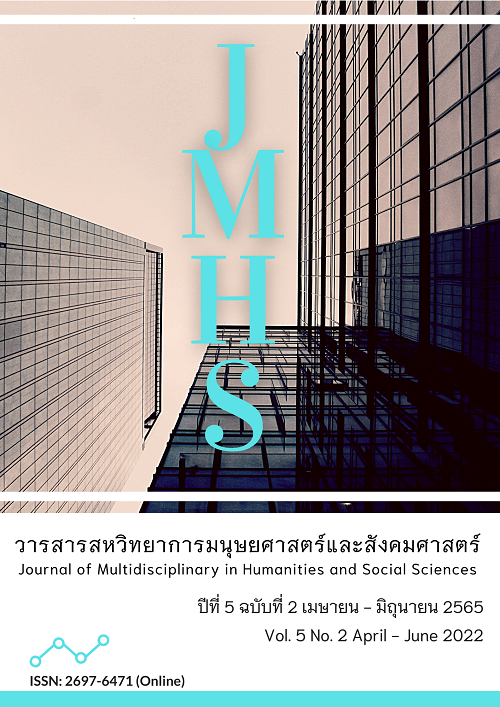An Analytical Study of The Relation Between Seven Factors of Enlightenment and Mindfulness on Breathing
Main Article Content
Abstract
The objectives of this article were 1) to study the contents and significant teaching of Seven Factors of Enlightenment; 2) to study the essential contents of Mindfulness on Breathing; and 3) to conduct an analytical study of the relationship between Seven Factors of Enlightenment and mindfulness on breathing. It was qualitative research. The results of the study showed that the relationship between the Seven Factors of Enlightenment and Mindfulness on Breathing showed that the Seven Factors of Enlightenment were included within Qualities contributing to Enlightenment. while Mindfulness on Breathing is in the Foundations of Mindfulness. i.e., contemplation of the body, which is also included in the qualities contributing to enlightenment. Both are related to each other as the factors of enlightenment. They are the kind of breath in-out mindfulness as follows: 1) in mindfulness the meditator uses mindfulness on mental formations or observed objects; 2) in truth Investigation he reminds the breathing in-out. observing the realities; 3) in effort he observes the in-out breaths with great efforts for realization; 4) in rapture he continues mindfulness of in-out breaths. detaching all happening raptures; 5) in calmness he still observes breathing in-out with relaxed and free mind; 6) in Concentration he continues mindfully observing the breathing in-out with one-pointed mind; and 7) in equanimity he with in-out breaths mindfulness, reaches the indifferent, neutral, detached mind by relying on serenity, dispassionateness, extinction, and bending to release all defilements. Having complete mindfulness on in-out breaths. meditator will surely attain the final realization and liberation.
Article Details

This work is licensed under a Creative Commons Attribution-NonCommercial-NoDerivatives 4.0 International License.
Views and opinions appearing in the Journal it is the responsibility of the author of the article, and does not constitute the view and responsibility of the editorial team.
References
พรมงคล ฉันท์รัตนโยธิน. (2561). โพชฌงค์ 7 กับพุทธจิตเสริมสุขภาพ. วารสารพุทธจิตวิทยา, 3(1), 29-37.
พระพรหมคุณาภรณ์ (ป.อ. ปยุตฺโต). (2554). พุทธธรรม ฉบับปรับขยาย. (พิมพ์ครั้งที่ 47). กรุงเทพฯ: ผลิธัมม์.
พระพรหมคุณาภรณ์ (ป.อ.ปยุตฺโต). (2549). โพชฌงค์: พุทธวิธีเสริมสุขภาพ. กรุงเทพฯ: โรงพิมพ์เจริญดีมั่นคงการพิมพ์.
พระพุทธโฆสเถระ. (2554). คัมภีร์วิสุทธิมรรค. (สมเด็จพระพุฒาจารย์ (อาจ อาสภมหาเถร), แปล). (พิมพ์ครั้งที่ 10). กรุงเทพฯ: ธนาเพรส .
พระมหานพดล นวตลปญฺโญ, พระครูสุธีคัมภีรญาณ (ประมวล) และ พระมหามิตร ฐิตปญฺโญ. (2564). รูปแบบการปฏิบัติธุดงควัตรของพระสงฆ์ในลุ่มแม่น้ำโขง (ไทย-ลาว). วารสารศิลปการจัดการ, 5(2), 325-339.
พระสมชาย บัวแก้ว, พระมหาบุญศรี วงค์แก้ว และ สุเชาวน์ พลอยชุม. (2564). อภิสมาจาร: กระบวนการพัฒนาบุคลิกภาพตามแนวพระพุทธศาสนา. วารสารศิลปการจัดการ, 5(3), 895-907.
มหาจุฬาลงกรณราชวิทยาลัย. (2552). อรรถกถาภาษาไทย ฉบับมหาจุฬาลงกรณราชวิทยาลัย. กรุงเทพฯ: โรงพิมพ์มหาจุฬาลงกรณราชวิทยาลัย.
มหาวิทยาลัยมหาจุฬาลงกรณราชวิทยาลัย. (2539). พระไตรปิฎกภาษาไทย ฉบับมหาวิทยาลัยมหาจุฬาลงกรณราชวิทยาลัย. กรุงเทพฯ: โรงพิมพ์มหาจุฬาลงกรณราชวิทยาลัย.
ราชบัณฑิตยสถาน. (2554). พจนานุกรมฉบับราชบัณฑิตยสถาน พ.ศ. 2544. กรุงเทพฯ: ศิริวัฒนาอินเตอร์พริ้นท์.
สมเด็จพระพุทธโฆษาจารย์ (ป. อ. ปยุตฺโต). (2561). พจนานุกรมพุทธศาสตร์ ฉบับประมวลธรรม. (พิมพ์ครั้งที่ 41). กรุงเทพฯ: ผลิธัมม์.
Damnoen, P. S. (2021). The Development of Student Characteristics in According to the Nawaluk Framework of the Buddhist integration of Buddhapanya Sri Thawarawadee Buddhist College. Asia Pacific Journal of Religions and Cultures, 5(2), 126-135.
Tan, C. C., & Damnoen, P. S. (2020). Buddhist Noble Eightfold Path Approach in the Study of Consumer and Organizational Behaviors. Journal of MCU Peace Studies, 8(1), 1–20.


